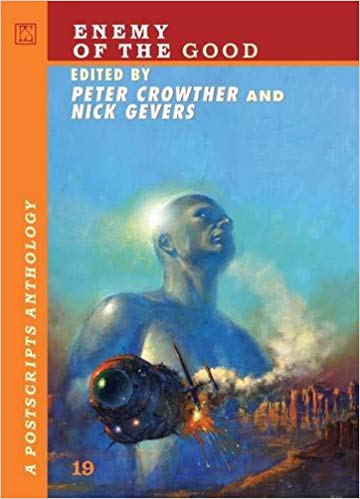 Edited by PETER CROWTHER, NICK GEVERS (PS Publishing; 2009)
Edited by PETER CROWTHER, NICK GEVERS (PS Publishing; 2009)
Here’s the latest installment of PS Publishing’s popular POSTSCRIPTS anthology series, showcasing horror, science fiction and the unclassifiable from a variety of authors. The contents are varied enough in style, quality and subject matter that it’s difficult to render any sort of overall verdict—to some of you I’m sure that fact will be off-putting, while others will take it as a strong recommendation. As for me, I’ll say this: I didn’t actively dislike any of the stories, which should be recommendation enough.
The rising fantasy specialist Daniel Abraham starts things off with the rip-roaring steam punk offering “Balfour and Meriwether in the Adventure of The Emperor’s Vengeance,” concerning the pursuit of a clockwork monstrosity through the sewers of 19th Century London. Following is Andrew Hook’s enjoyable “Bigger Then The Beetles,” about synthetic frogs that grow really, really big when placed in water; the things happen to serve a definite purpose, which we discover in the story’s final pages.
Tim Lees’ “Meeting Mr. Tony” is an almost Bradbury-esque account of Mr. Tony, who invades the life of the London-based protagonist, a young boy–but of course there’s far more to Mr. Tony, and the protagonist’s world, than meets the eye. Scott Edelman’s “The World Breaks” is a searingly bleak look at America in the wake of a nuclear war, related through letters written by parents to their children and vice-versa. “The Portrayed Man” by Justin Cartaginese has a terrific TWILIGHT ZONE-ish premise—an overworked man procures the services of an agency that replaces people like himself with look-alike actors–but an unsatisfying ending. The title story by Matthew Hughes is a novella-length science fiction piece involving interstellar thieves and a long-vanished cult. It’s well written, but also excessively drawn-out and dull.
Chris Beckett‘s “The Famous Cave Paintings on Isolus 9” is another one for the sci fi field. It concerns a cosmonaut writer who travels to a distant planet whose primitive inhabitants live underground, wherein a series of cave paintings lead to intriguing speculations on the nature of religion and reality itself. I found the story a bit overwritten, but it has a powerfully haunting air. Continuing the fame theme is “Famous People” by Ron Savage. This one has a vaguely supernatural vibe, but is notable mostly for its thoughtful and all-too-realistic look at the pratfalls of stardom, as represented by a popular child actress, her plain-Jane sister and a long-dead girl starlet, whose outdated but still relevant diary entries punctuate the tale.
There are a few short, surreal oddities. “The Cacto Skeleton” by David T. Wilbanks has a walking skeleton whose touch causes people to fall down dead. “A Life Clichéd” by David N. Drake is an intriguing two-pager about a couple shopping for an offspring in a store called Birth Rite, which sells children with pre-destined futures. Oddest of all is “The Red King’s Sleep” by Marly Youmans, a wild, unclassifiable dream tale.
The final story is “The Warlock and the Man” by M.K. Hobson. It’s a weird western that reads like the NIGHT WATCH books/movies transposed to Wild West America, with a race of monstrous “Hell Niggers,” led by the demonic Mountain King, existing in uneasy conjunction with the human residents of a small town. But when the brother of the Mountain King is gunned down the truce is shattered, leading to a supernatural showdown. A good story, and also a good book.
